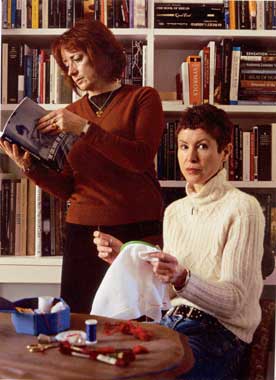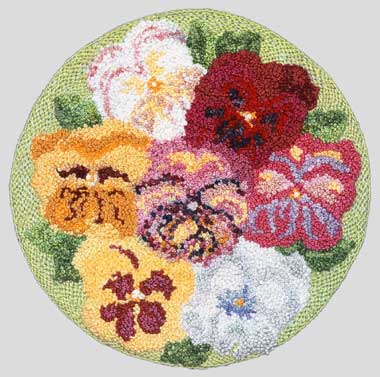There has been much celebratory press about O’Brien’s interpretation of the seven sacraments as it is finally put on show in Ireland. There have also been extensive descriptions of her metaphors and references. There is no need to repeat these descriptions. Because, in many cases, description seems to have replaced criticism, there is a greater need to look at some of the unspoken presuppositions made by both press and artist concerning the content and presentation of this work.
 |
| Abigail O’Brien; Dream kitchen, 1998, cibachrome print on aluminium, 76 x 66 cm: courtesy RHA |
From the start, let it be said that there is little that is radically feminist in making a wholesale substitution of women for men in a traditionally male iconography. If nothing else, it was made with greater astuteness and economy of means, and in a more restrictive environment, over a century ago by painters such as Mary Cassatt and Berthe Morisot. This ‘radical’ substitution is belated, then. Moreover, it might unwittingly confirm the authority it wishes to displace, as it makes the assumption that this traditional authority has been corrupted, and therefore, conversely, that it might be at some level legitimate (I shall return to this point).
Two rather loose threads weave together each chapter of this series. Firstly, the notion that these rituals “are both an anchor and a noose and are a way of navigating the complexities of life"; that they are rites of passage into one’s cultural milieu and that, although restrictive, these sacraments can still confer meaning and ‘grace’ upon one’s activities. Secondly, that the duality of the sacred and the profane is repeated in the conflict between, respectively, the vita contemplativa and the vita activa; a contest played out within a closed, female space, and personified in the Biblical story of Christ’s visit to Martha and Mary. From this latter story onwards, the hierarchy between the two ‘lives’ has been maintained, with contemplation, abstraction, and reflection taking precedence over action, instinctual passions, and manual labour.
Both of these threads are familiar enough, and both have their problems: some quite radical reinterpretation and presentation would therefore be required by this work if it were not to rehearse common truisms.
 |
| Abigail O’Brien; The Last Suppe r, 1995, cibachrome print on aluminium, 96 x 76 cm: courtesy RHA |
In the first three sacraments – Last Supper, Baptism, and Kitchen pieces – Confession + Communion – these threads are woven through domestic spaces. Many references are made to (predominantly Dutch) genre painting of the seventeenth century, when the nascent bourgeoisie made the ‘feminine’ space of the domestic interior the site of moral education. A capricious Nature came up against the exemplary life; a life ordered, secured and instituted by the observance of certain ritualised practices. The prestige now afforded these genre paintings – as examples of a ‘timeless’ yet unique golden era – is contrary to their original grotesqueness, their peculiar admixture of refinement and crude realism, of institutional perseverance and material decay. Certainly, O’Brien’s colour range and meticulous finish refer back to such painters as Gerrit Dou; but the forced staging of her over-stylised images admits of no crudity. The blank-faced artifice of the Kitchen pieces suggests a communal life replaced by the absolute ritual of Communion, not invigorated by it: a living, bodily proximity reified, and the actions of bodies renewing themselves sublimated into, and disavowed by, language. In a way, nothing could be more distorted, more grotesque: but it is a distortion that subordinates the body, making it an object of guilt and shame. For instance, the sound-piece Telling verbs sounds apologetic, like a confession of maybe using one’s mouth for something other than recitation.
O’Brien’s presentation is rather polite – more an aesthetic than aesthetic. It evacuates the extremities of aesthetic experience found in obscene laughter, vulgarity, and libidinal sensation; the latter being an aesthetics which might, “in a play of erotic solidarity with others," destabilise ruling civilities and monological authority, by overriding the precious self-identity of bodies isolated from one another. There can be no possibility here of that reconciliation and devotional community promised by these three sacraments: communion is forever deferred, abstracted; its recipients are always-already ‘imperfect’, ‘in sin’. Hence, the melancholy.
This is where O’Brien’s substitution of female protagonists falls flat, as the forms wherein this substitution is staged reiterate the authority of the sacramental doctrine. Her clinical operations sterilise the vita activa; the kitchen is abstracted from the labour that would disturb its surface gloss; the bread is stale or turned to wood, or it becomes silver, a currency of social hierarchy and material gain rather than of collectivity.
 |
| Abigail O’Brien; Still life VII, 1998, cibachrome print on aluminium, 66 x 51 cm: courtesy RHA |
Considering the above, it is curious that not more has been made of the structural similarity between the transcendent principles animating the sacraments and capitalist property relations. The process of commodity fetishism is a well-known consequence of capitalist economics, where an ordinary object acquires an aura; something in excess of its corporeal dimension. Money, the universal equivalent, embodies that excess value of exchange that makes an object a commodity. Likewise, Christ embodies the excess, Sin, of humanity. We might say that Christ is “like money among men" (Marx) – He is also a commodity. However, O’Brien presents the commodification of the sacraments not as some incorrigible structural flaw, but as the result of some overbearing institutional conformity, as some ‘fall from grace’, which has diverted religious order from its true elemental significance.
Commodity fetishism might be, under certain social conditions, a parasite upon the drive to religious transcendence, but it can only be so because of its convenience to Christian doctrine. The various religious mechanisms of sublimation, idealisation, disavowal and repression are also those of the commodity: and these mechanisms are themselves guilty of the ‘original sin’ of abstraction from the material existence of labouring bodies, which extends the body by abstracting it and thereby violates its sensuous nature. Both divide the body into an ordinary, active life and a spectral, ‘undead’, or sacred life, which creates an aura around the ordinary.
If private property “is the ‘sensuous expression’ of humanity’s estrangement from its own body, the dismal displacement of our sensuous plenitude onto a single drive to possess" (Terry Eagleton), then it is more than a little ironic that O’Brien’s implied audience are those to whom capitalism has bestowed the greatest abundance of gifts: an audience seemingly so self-satisfied that it cannot perceive its own dispossession at the same time that it makes a fetish of its environment. And even to bemoan alienated labour and a loss of faith at the very same time that one reproduces them would be a rather vacuous gesture.
 |
| Abigail O’Brien; T he sewing lesson II, 2001-4, cibachrome on aluminium, 120 x 96 cm; courtesy RHA |
Perhaps being caught between the two poles of the active and contemplative life is more a categorical problem than one which comes to bear in practice . The philosopher Michel de Certeau has spoken of activities that are self-conscious and tactical: modes of practice that have no proper institutional place, and that are always incomplete and polymorphous. There is a ‘cleverness’ to the most everyday practices – such as cooking, eating and preparing gifts – which manipulates events and appropriates symbols so as to make them into opportunities. The important point is that cultural rituals cannot be wholly prescriptive – they are guided by what de Certeau calls an ‘operational logic’. Or in other words, theoretical reflection, the vita contemplativa, is itself a material practice: the elements of thought, i.e. language, have somatic foundations, in a body that is also a sign system.
O’Brien paralyses this operational logic when she attempts to re-inscribe an institutional sign system upon its activities. She paralyses it because she forces an unnecessary division, leading to two incompatible ‘lives’. Perhaps this is why the gestures and expressions of her female characters are so anxious, so forced (except, it seems, in the figure of the lady at home in her garden in The gardener I and II ). It also puts strain upon her metaphors. For instance, in Garden heaven – Holy Orders, “nature is the metaphor for sexuality." A rather easy metaphor, perhaps: the artifice of the garden environment is appropriate, but then we must also carry this artifice over to ‘natural’ instincts and intuitions, and ask just how ‘unruly’ is the ‘natural’ garden allowed to be within O’Brien’s sensibility. One would have thought that sexuality in its natural state is a little more unruly than an old lady’s private garden. We see the same double operation, albeit on a different scale, in the priest’s confinement to celibacy and the lady’s channelling “her desire to grow and nurture into her plants." Both, predictably, displace the object of desire by prohibiting it from the start; and both then make this displacement (tending the garden; being ever vigilant towards temptation) erotic by making it an end in itself. For O’Brien, the similarity, and inevitability, of these operations is overlooked and a simplistic division is made: old lady in her ‘unruly’ garden – the Good Life; a priest suppressing his ‘unformed desires’ – the Bad Life. The reference to the prohibition against women priests seems to be an afterthought that fails to be articulated in the work.
 |
| Abigail O’Brien; Memento no. 1, 2000, hand-embroidered sampler, linen, cotton, silk, 18 cm diameter: courtesy RHA |
In Extreme Unction – from the Ophelia Room we are in the presence of death: an empty, paralysed space that speaks of unrequited love and of waiting for an absence to be filled. The tragedy is, however, less that Ophelia’s love for Hamlet is unreciprocated than that suicide is the only choice available to her. To suggest, as does O’Brien, that Ophelia’s death was accidental, and that therefore she is “neither dead nor fully alive," is to preclude this moment of ‘pure decision’ by keeping it in suspension. To make this death an act without volition might be to cajole some sympathy for Ophelia’s dramatic Pre-Raphaelite fate but it is also to avoid the far more pertinent, because more contemporary, case that suicide might not be the result of suffering, illness, etc, but a final, existential act in a life otherwise denied spontaneous gestures.
 |
| Abigail O’Brien; Memento no. 5, 2000, hand-embroidered sampler, linen, cotton, silk, 26 x 15 cm: courtesy RHA |
This leads, lastly, to another loose thread running through this exhibition: the notion that there is a conflict between the freely expressed or individuated thought and social conformity. This conflict might be something of a chimera. The ‘freedom’ of individual choice advocated by a liberal ideology, the choice to appropriate from a traditional iconography one’s own rite of passage, to make it ‘true’ to oneself, is only a formal freedom, a ‘forced choice’: it is a choice already made elsewhere. This ‘choice’ is grafted onto the subject’s inner personality and thereby naturalised. Consequently, the subject remains unaware of their subordination. In a way then, the subject ‘free’ to make a personal, secular choice is less free than the one whose choices are explicitly made according to some higher power.
The subject most free is the one who chooses not to choose within a pre-given set of coordinates, however much these might be reinterpreted, but the one who makes the ‘impossible’ choice of actually changing these coordinates (Slavoj Zizek). It is this decision that Ophelia makes: she suspends, and thereby supersedes, the authority of the sacrament of matrimony. Hence, her love for Hamlet remains faithful and eternal; but the price for this is, of course, that Ophelia must take her own life. Strangely enough, this primordial reinvention of the terms of existence is also at the core of Christianity: it is the logic of religious sacrifice as such, and it is a decision whose representation O’Brien forecloses from the start.
Tim Stott is a writer based in Dublin.